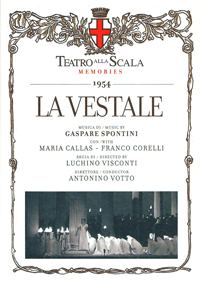Written 1805 Composer Gaspare Spontini | First performance 15 December 1807 Language French | |
 | ||
Librettist Victor-Joseph Étienne de Jouy Similar Olimpie, Agnes von Hohenstaufen, Médée, Il pirata, Poliuto | ||
Gaspare spontini la vestale overture
La vestale (The Vestal Virgin) is an opera composed by Gaspare Spontini to a French libretto by Étienne de Jouy. It takes the form of a tragédie lyrique in three acts. It was first performed on 15 December 1807 by the Académie Impériale de Musique (Paris Opera) at the Salle Montansier, and is regarded as Spontini's masterpiece. The musical style shows the influence of Gluck and looks forwards to the works of Berlioz, Wagner and French Grand Opera.
Contents
- Gaspare spontini la vestale overture
- La vestale gaspare spontini 1993
- Composition history
- Performance history
- Synopsis
- Act 1
- Act 2
- Act 3
- Recordings
- References
La vestale gaspare spontini 1993
Composition history
Spontini had finished La vestale by the summer of 1805 but had faced opposition from leading members of the Opéra and rivalry from fellow composers. The premiere was made possible with the help of Spontini's patron, the Empress Josephine, but only after being rearranged by Jean-Baptiste Rey and Louis-Luc Loiseau de Persuis. La vestale was an enormous success, enjoying over two hundred performances by 1830.
Performance history
Its fame soon spread abroad; it first appeared on the Italian stage in Naples in 1811, and it was performed in Stockholm in 1823. It was premiered in the United States in French at Théâtre d'Orléans in New Orleans on 17 February 1828. Important 20th-century revivals include the 1954 production at La Scala with Maria Callas in the title role, which was the first opera staging by the famous film director Luchino Visconti. La vestale is famous in historical terms but is only very infrequently performed. Two of its arias (translated to Italian and recorded by Maria Callas and Rosa Ponselle), "Tu che invoco" and "O Nume tutelar", are better known than the work as a whole. In recognition of its role in the development of Richard Wagner's third opera, Rienzi, it was performed in concert form in Dresden's Semperoper in the Summer of 2013, conducted by Gabriele Ferro and starring Francisco Araiza as Cinna, Maria Agresta as Julia, and baritone Christopher Magiera as Licinius.
Synopsis
Place: Rome About 269 BCAct 1
Returning to Rome after a victorious campaign, Licinius finds his beloved Julia has become a priestess of Vesta. Although Julia attempts to avoid going to Licinius's triumph, she is delegated to present him with a wreath. He tells her that he intends to kidnap and reclaim her.
Act 2
In the temple of Vesta, Julia guards the eternal flame and prays to be freed of temptation. Licinius arrives; during their rapturous reconciliation, the flame expires. Licinius is advised by Cinna to flee. Julia is interrogated by the High Priest but refuses to name Licinius. She is sentenced to death for licentiousness.
Act 3
Despite the pleas of Licinius, Julia is to be buried alive; even when he admits his intrusion to the Temple, Julia claims not to recognise him. A thunderstorm ensues, during which lightning reignites the sacred flame. Recognising this as a sign from the Gods, the High Priest and Vestal Priestess release Julia who is then married to Licinius.
